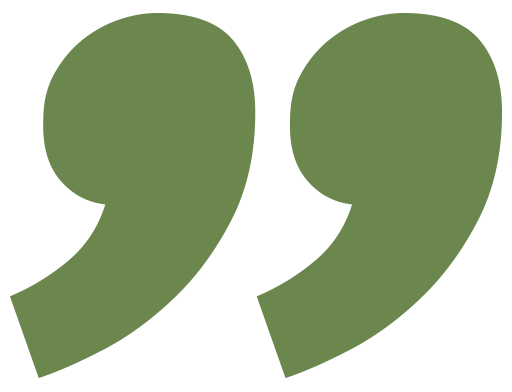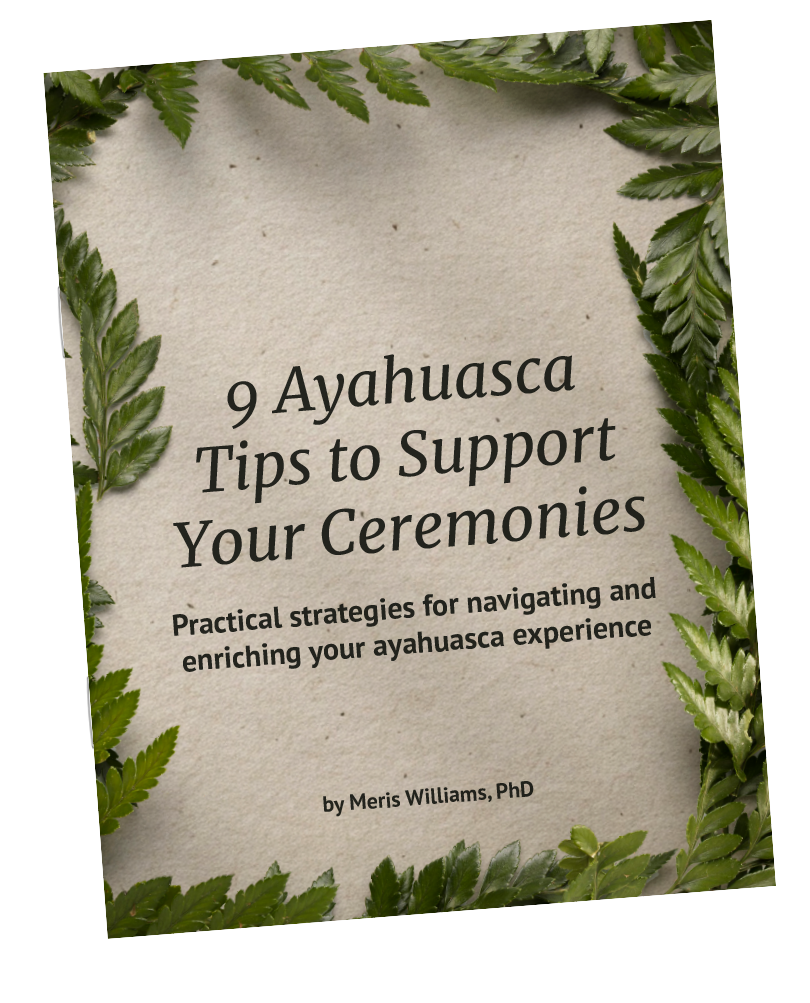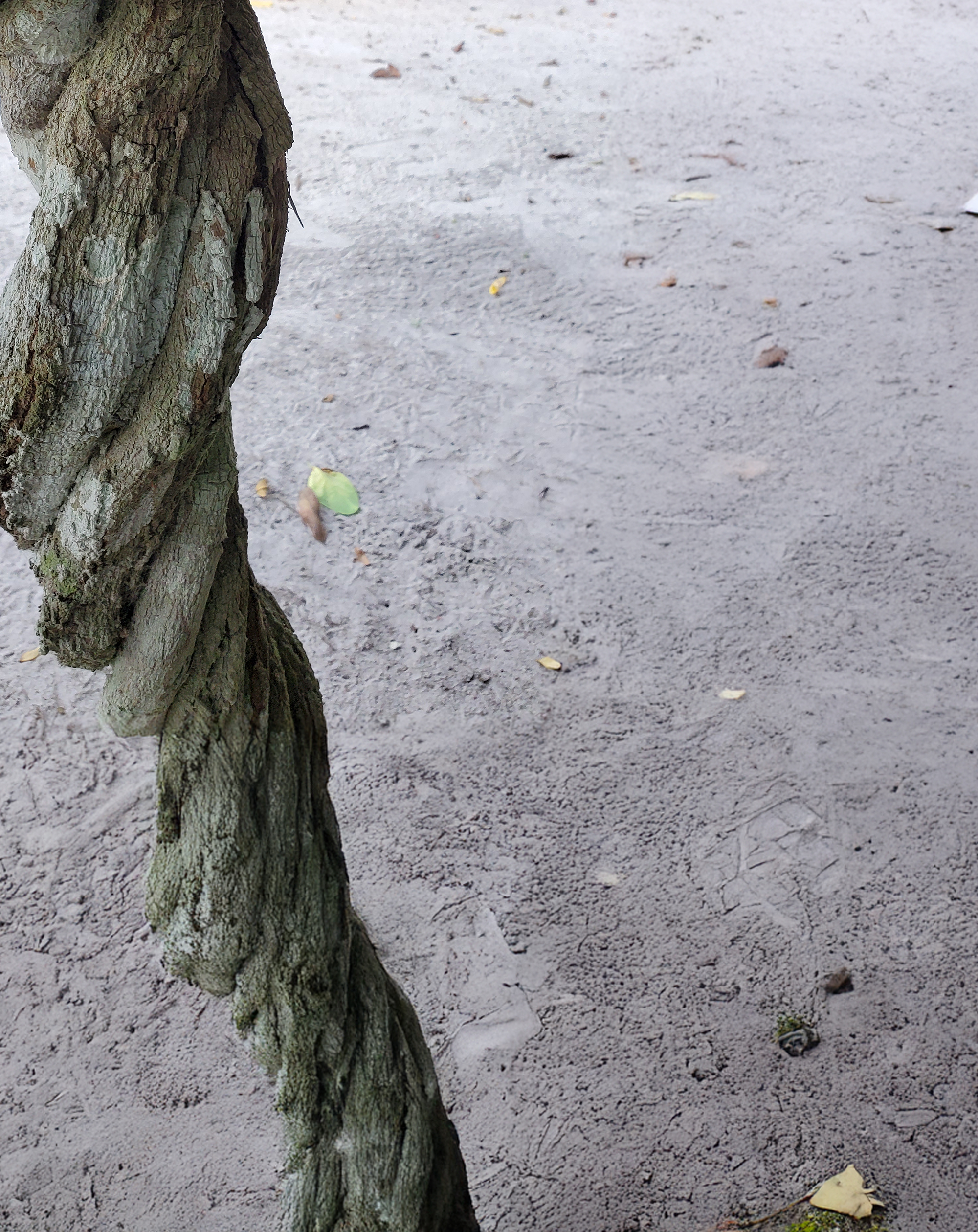Resources
Increase Your Knowledge of Ayahuasca
Resources
Increase Your Knowledge of Ayahuasca
Enriching your knowledge base
Learning about ayahuasca is also a journey
I knew absolutely zero about ayahuasca before I started drinking it. I wish I’d had more guidance and information in those early months and years as I stepped into this world.
Through my personal ceremony experiences and my research activities, the more I’ve learned about ayahuasca – its origins, and the communities and cultures in which it’s used – the more my relationship with it has become increasingly rich, meaningful, and humbling.
The top books on psychedelics may or may not include information about ayahuasca, and there’s a lot of confusing, misleading, and overly romanticized information about ayahuasca online. I’m aiming to offer a helpful and healthy alternative here with a few credible resources. I hope they spark clarity or inspiration, support your or someone else’s ayahuasca journey, aid you in informed decision-making, or help you feel less alone.
You can also start with my free resource, 9 Ayahuasca Tips to Support Your Ceremonies.
Bookmark-worthy sites
Organizations promoting safety, research, inclusion, and respect for ayahuasca’s origins
ICEERS
The International Centre for Ethnobotanical Education, Research, and Service (ICEERS) is “a non-profit organization dedicated to navigate the challenges of the globalization of Traditional Indigenous Medicines.” ICEERS offers information, support, advocacy, research, and community-building resources. They’ve compiled statistics on global ayahuasca use, and offer an abundance of reliable information about ayahuasca and other plant medicines, including iboga and cannabis.
Chacruna
Chacruna is an organization that offers educational programs on plant medicines, conducts research, hosts conferences, and generally is a progressive and credible resource in the psychedelic space. Their mission is to “promote reciprocity in the psychedelic community, and support the protection of sacred plants and cultural traditions. We advance psychedelic justice through curating critical conversations and uplifting the voices of women, queer people, Indigenous peoples, people of color, and the Global South in the field of psychedelic science.”
I’ve attended several of Chacruna’s excellent educational offerings, including workshops, discussions, and a 14-week course entitled Ayahuasca Healing, Science and Indigenous Knowledge.
Chacruna provides a range of online articles, but one of their most important publications is the Ayahuasca Community Guide for the Awareness of Sexual Abuse.
What we learned
Our research with Western ayahuasca ceremony leaders
“Meeting the medicine halfway”: Ayahuasca ceremony leaders’ perspectives on preparation and integration practices for participants
Callon, C., Williams, M., & Lafrance, A. (2021). The Journal of Humanistic Psychology, 1–27.
Ayahuasca ceremony leaders described preparation and integration practices they consider helpful for ensuring safe and productive experiences for ceremony participants.
Ceremony leaders’ perspectives on the good, the bad, and the ugly of ayahuasca drinking in ceremonial contexts
Williams, M., Crotty, S., Callon, C., & Lafrance, A. (2022a). The Journal of Transpersonal Psychology, 54(2), 141–167.
Ayahuasca ceremony leaders offered their perspectives on facilitative ceremony conditions, contraindications for drinking ayahuasca, and psychedelic emergencies. An inventory of every concern related to ceremonial ayahuasca use mentioned by the leaders is also presented.
"Getting to the root": Ayahuasca ceremony leaders’ perspectives on eating disorders
Williams, M., Kingston Miller, A., Loizaga-Velder, A., Files, N., & Lafrance, A. (2022b). Journal of Psychoactive Drugs. Advance online copy.
Ayahuasca ceremony leaders provided their conceptualizations of eating disorders and the potential therapeutic mechanisms of action of ayahuasca for individuals living with them.
Ayahuasca ceremony leaders’ perspectives on special considerations for eating disorders
Williams, M., Kingston Miller, A., & Lafrance, A. (2024). Eating Disorders: The Journal of Treatment and Prevention, 32(2), 120–139.
Ayahuasca ceremony leaders shared their perspectives on screening for eating disorders, the role of purging and dietary restrictions, potential risks, and how ayahuasca might complement conventional eating disorder treatment. We proposed that considering Indigenous approaches could evolve conventional models of eating disorders treatment, and that collaborations might be best invited in a decolonizing, bidirectional process bridging Western and Indigenous healing paradigms.
References and sources
A complete list of the materials cited throughout this website
Araújo, D. B. (2019). The impact of ayahuasca on suicidality: Results from a randomized controlled trial. Frontiers in Pharmacology, 10, Article 1325. https://doi.org/10.3389/fphar.2019.01325
Argyri, E. K., Evans, J., Luke, D., Michael, P., Michelle, K., Rohani-Shukla, C., ... & Robinson, O. (2024). Navigating groundlessness: An interview study on dealing with ontological shock and existential distress following psychedelic experiences. https://ssrn.com/abstract=4817368
Aronovich, A. A., & Labate, B. C. (2021). Healing at the intersections between tradition and innovation: An interview with Shipibo Onaya Jorge Ochavano Vasquez. In B. C. Labate & C. Cavnar (Eds.), pp. 227–242. Ayahuasca Healing and Science. Springer. https://doi.org/10.1007/978-3-030-55688-4_13
Aschaiek, S. (2021). Drawing on Indigenous wisdom to become ecological citizens: 2021 Snider Lecture. https://www.utm.utoronto.ca/main-news/drawing-indigenous-wisdom-become-ecological-citizens-2021-snider-lecture
Bahji, A., Forsyth, A., Groll, D., & Hawken, E. R. (2020). Efficacy of 3, 4-methylenedioxymethamphetamine (MDMA)-assisted psychotherapy for posttraumatic stress disorder: a systematic review and meta-analysis. Progress in Neuro-Psychopharmacology and Biological Psychiatry, 96, 109735. https://doi.org/10.1016/j.pnpbp.2019.109735
Barbosa P. C., Giglio J. S., & Dalgalarrondo, P. (2005). Altered states of consciousness and short-term psychological after-effects induced by the first time ritual use of ayahuasca in an urban context. Brazilian Journal of Psychoactive Drugs, 37, 193–201. https://doi.org/10.1080/02791072.2005.10399801
Barbosa, P. C., Cazorla, I. M., Giglio, & J. S., Strassman, R. (2009). A six-month prospective evaluation of personality traits, psychiatric symptoms and quality of life in ayahuasca-naïve subjects. Journal of Psychoactive Drugs, 41, 205–12. https://doi.org/10.1080/02791072.2009.10400530
Brabec de Mori, B. B. (2017). Paths of healing, voices of sorcerers. The ambivalence of Shipibo curative songs in Amazonia. Terrain, 68. https://doi.org/10.4000/terrain.16425
Brabec de Mori, B. (2021). The power of social attribution: Perspectives on the healing efficacy of ayahuasca. Frontiers in Psychology, 12, Article 748131. https://doi.org/10.3389/fpsyg.2021.748131
British Columbia Association of Clinical Counsellors (2024). Health Canada guidelines to working with psychedelics: Implications for Registered Clinical Counsellors. https://bcacc.ca/wp-content/uploads/2024/10/Health-Canada-Guidelines-on-Psychedelic-Assisted-Therapy-2024.pdf
Callaway, J. C., & Grob, C. S. (1998). Ayahuasca preparations and serotonin reuptake inhibitors: A potential combination for severe adverse interactions. Journal of Psychoactive Drugs, 30(4), 367–369. https://doi.org/10.1080/02791072.1998.10399712
Callaway, J. C., McKenna, D. J., Grob, C. S., Brito, G. S., Raymon, L. P., Poland, R. E., ... & Mash, D. C. (1999). Pharmacokinetics of hoasca alkaloids in healthy humans. Journal of Ethnopharmacology, 65(3), 243–256. https://doi.org/10.1016/s0378-8741(98)00168-8
Callon, C., Williams, M., & Lafrance, A. (2021). “Meeting the medicine halfway”: Ayahuasca ceremony leaders’ perspectives on preparation and integration practices for participants. The Journal of Humanistic Psychology, 1–27. https://doi.org/10.1177/00221678211043300
Cappo, S. M. (2018). What ayahuasca wants: Notes for the study and preservation of an entangled ayahuasca. In B. C. Labate & Cavnar, C. (Eds.), The expanding world ayahuasca diaspora (pp. 157–176). Routledge. https://doi.org/10.4324/9781315227955
Carhart-Harris, R. L., & Friston, K. J. (2019). REBUS and the anarchic brain: Toward a unified model of the brain action of psychedelics. Pharmacological Reviews, 71(3), 316-344. https://doi.org/10.1124/PR.118.017160
de Lima Osório, F., Sanches, R. F., de Macedo, L. R., dos Santos, R. G., Maia-de-Oliveira, J. P., Wichert-Ana, L., de Araújo, D. B., Riba, J., Crippa, J. A., & Hallak, J. E. (2015). Antidepressant effects of a single dose of ayahuasca in patients with recurrent depression: A preliminary report. Brazilian Journal of Psychiatry, 37(1), 13-20. https://doi.org/10.1 590/1516-4446-2014-1496
Dobkin de Rios, M., & Rumrrill, R. (2008). A hallucinogenic tea, laced with controversy: Ayahuasca in the Amazon and the United States. Praeger.
Domínguez-Clavé, Soler, J., Elices, M., Pascual, J. C., Álvarez, E., de la Fuente Revenga, M., Friedlander, P., Feilding, A., & Riba, J. (2016). Ayahuasca: Pharmacology, neuroscience and therapeutic potential. Brain Research Bulletin, 126, 89–101. https://doi.org/10.1016/j.brainresbull.2016.03.002
dos Santos, R. G., Bouso, J. C., & Hallak, J. E. C. (2017). Ayahuasca, dimethyltryptamine, and psychosis: A systematic review of human studies. Therapeutic Advances in Psychopharmacology, 7(4), 141–157. https://doi.org/10.1177/2045125316689030
dos Santos, R. G., Balthazar, F. M., Bouso, J. C., & Hallak, J. E. C. (2016). The current state of research on ayahuasca: A systematic review of human studies assessing psychiatric symptoms, neuropsychological functioning, and neuroimaging. Journal of Psychopharmacology, 30(12), 1230–1247. https://doi.org/10.1177/0269881116652578
dos Santos, R. G., & Hallak, J. E. C. (2021). Ayahuasca, an ancient substance with traditional and contemporary use in neuropsychiatry and neuroscience. Epilepsy & Behavior, 121, Article 106300. https://doi.org/10.1016/j.yebeh.2019.04.053
dos Santos, R. G., Landeira-Fernandez, J., Strassman, R. J., Motta, V., & Cruz, A. P. M. (2007). Effects of ayahuasca on psychometric measures of anxiety, panic-like and hopelessness in Santo Daime members. Journal of Ethnopharmacology, 112(3), 507-513. https://doi.org/10.1016/j.jep.2007.04.012
Fosha, D. (2000). The transforming power of affect: A model for accelerated change. Basic Books.
Fosha, D. (2021). How AEDP works. In D. Fosha (Ed.), Undoing aloneness and the transformation of suffering into flourishing (pp. 27–52). American Psychological Association.
Fotiou, E. (2016). The globalization of ayahuasca shamanism and the erasure of indigenous shamanism. Anthropology of Consciousness, 27(2), 151–179. https://doi.org/10.1111/anoc.12056
Fotiou, E., & Gearin, A. K. (2019). Purging and the body in the therapeutic use of ayahuasca. Social Science & Medicine 239, Article 112532. https://doi.org/10.1016/j.socscimed.2019.112532
Frecska, E. (2007). Therapeutic guidelines: Dangers and contraindications in therapeutic applications of hallucinogens. In M. J. Winkelman & T. B. Roberts (Eds.), Psychedelic medicine: New evidence for hallucinogenic substances as treatments (pp. 69–95). Praeger.
Gable, R. S. (2007). Risk assessment of ritual use of oral dimethyltryptamine (DMT) and harmala alkaloids. Addiction, 102(1), 24–34. https://doi.org/10.1111/j.1360-0443.2006.01652.x
Giove Nakazawa, R. A. (2022). The ayahuasca ritual: Peruvian national cultural heritage and its possible integration into the primary health system. Revista Cultura y Droga, 27(33), 17-41. https://doi.org/10.17151/culdr.2022.27.33.2
Gomez-Sousa, M., Jiménez-Garrido, D. F., Ona, G., dos Santos, R. G., Hallak, J. E. C., Alcázar-Córcoles, M. A., & Bouso, J. C. (2021). Acute psychological adverse reactions in first-time ritual ayahuasca users. Journal of Clinical Psychopharmacology, 41(2), 163–171. https://doi.org/10.1097/JCP.00000000000013
Griffiths, R. R., Johnson, M. W., Carducci, M. A., Umbricht, A., Richards, W. A., Richards, B. D., ... & Klinedinst, M. A. (2016). Psilocybin produces substantial and sustained decreases in depression and anxiety in patients with life-threatening cancer: A randomized double-blind trial. Journal of Psychopharmacology, 30(12), 1181-1197. https://doi.org/10.1177/0269881116675513
Haijen, E. C., Kaelen, M., Roseman, L., Timmermann, C., Kettner, H., Russ, S., Nutt, D., Daws, R. E., Hampshire, A. D. G., Lorenz, R., & Carhart-Harris, R. L. (2018). Predicting responses to psychedelics: a prospective study. Frontiers in Pharmacology, 9, 897. https://doi.org/10.3389/fphar.2018.00897
Harris, R. (2017). Listening to ayahuasca: New hope for depression, addiction, PTSD, and anxiety. New World Library.
Hartogsohn, I. (2017). Constructing drug effects: A history of set and setting. Drug Science, Policy and Law, 3. https://doi.org/10.1177/2050324516683325
International Center for Ethnobotanical Education, Research and Service (ICEERS). (2023, June). Executive summary: Ayahuasca, global consumption & reported deaths. https://www.iceers.org/ayanumbers-en/
Jacob, M. A., & Presti, D. E. (2005). Endogenous psychoactive tryptamines reconsidered: An anxiolytic role for dimethyltryptamine. Medical Hypotheses, 64(5), 930–937. https://doi.org/10.1016/j.mehy.2004.11.005
Lafrance, A., (June 13, 2025). Psychedelic medicine and harm reduction support [online course]. https:// dradelelafrance.com/psychedelicskill
Lafrance, A., (n.d.). Guide for preparation clinicians and coaches. Author.
Lafrance, A., Loizaga-Velder, A., Fletcher, J., Renelli, M., Files, N., & Tupper, K. W. (2017). Nourishing the spirit: Exploratory research on ayahuasca experiences along the continuum of recovery from eating disorders. Journal of Psychoactive Drugs, 49(5), 427– 435. https://doi.org/10.1080/02791072.2017.1361559
Leary, T., Litwin, G. H., & Metzner, R. (1963). Reactions to psilocybin administered in a supportive environment. Journal of Nervous and Mental Disease, 137, 561- 573. https://doi.org/10.1097/00005053-196312000-00007
Lemmens, P. (May 14, 2019). Re-enchantment of the world. The ontological subversion of the ayahuasca experience. Radboud-Reflects lecture, Radboud University, Nijmegen, The Netherlands. https://www.academia.edu/download/109235066/Re_enchantment_of_the_world_lecture.pdf
Loizaga-Velder, A., & Verres, R. (2014). Therapeutic effects of ritual ayahuasca use in the treatment of substance dependence – Qualitative results. Journal of Psychoactive Drugs 46(1), 63–72. https://doi.org/10.1080/02791072.2013.873157
Luna, L. E. (2011). Indigenous and mestizo use of ayahuasca. An overview. In R. G. dos Santos (Ed.), The ethnopharmacology of ayahuasca (pp. 1–21). Transworld Research Network.
Marcus, O. (2022). ‘Everybody’s creating it along the way’: Ethical tensions among globalized ayahuasca shamanisms and therapeutic integration practices. Interdisciplinary Science Reviews, 1–20. https://doi.org/10.1080/03080188.2022.2075201
McKenna, D. J. (2004). Clinical investigations of the therapeutic potential of ayahuasca: rationale and regulatory challenges. Pharmacology & Therapeutics, 102(2), 111–129. https://doi.org/10.1016/j.pharmthera.2004.03.002
McKenna, D., & Riba, J. (2018). New world tryptamine hallucinogens and the neuroscience of ayahuasca. In A. L. Halberstadt, F. X. Vollenweider, & D. E. Nichols (Eds.), Behavioral neurobiology of psychedelic drugs. Current topics in behavioral neurosciences, Vol 36 (pp. 283–311). Springer. https://doi.org/10.1007/7854_2016_472
Mitchell, J. M., Bogenschutz, M., Lilienstein, A., Harrison, C., Kleiman, S., Parker-Guilbert, K., ... & Doblin, R. (2023). MDMA-assisted therapy for severe PTSD: a randomized, double-blind, placebo-controlled phase 3 study. Focus, 21(3), 315-328. https://doi.org/10.1038/s41591-021-01336-3
Nai, R. (2021, 2022). Ronin’s teachings [Online course].
Nardou, R., Sawyer, E., Song, Y. J., Wilkinson, M., Padovan-Hernandez, Y., De Deus, J. L., ... & Dölen, G. (2023). Psychedelics reopen the social reward learning critical period. Nature, 618(7966), 790-798. https://doi.org/10.1038/s41586-023-06204-3
O’Shaughnessy, D. M., Berlowitz, I., Rodd, R., Sarnyai, Z., & Quirk, F. (2021). Within- treatment changes in a novel addiction treatment program using traditional Amazonian medicine. Therapeutic Advances in Psychopharmacology, 11, 2045125320986634– 2045125320986634. https://doi.org/10.1177/2045125320986634
Palhano-Fontes, F., Barreto, D., Onias, H., Andrade, K. C., Novaes, M. M., Pessoa, J. A., Mota-Rolim, S. A., Osório, F. L., Sanches, R., dos Santos, R. G., Tófoli, L. F., de Oliveira Silveira, G., Yonamine, M., Riba, J., Santos, F. R., Silva-Junior, A. A., Alchieri, J. C., Galvão-Coelho, N. L., Lobão-Soares, B.,. . . de Araújo, D. B. (2019). Rapid antidepressant effects of the psychedelic ayahuasca in treatment-resistant depression: A randomized placebo-controlled trial. Psychological Medicine, 49(4), 655–663. https://doi.org/10.1017/S0033291718001356
Peluso, D. M. (2014). Ayahuasca’s attractions and distractions: Examining sexual seduction in shaman-participant interactions. In B. C. Labate & C. Cavnar (Eds.), Ayahuasca shamanism in the Amazon and beyond (pp. 231–255). Oxford University Press.
Perkins, D., Opaleye, E. S., Simonova, H., Bouso, J. C., Tófoli, L. F., Galvão-Coelho, N. L., Schubert, V., & Sarris, J. (2022). Associations between ayahuasca consumption in naturalistic settings and current alcohol and drug use: Results of a large international cross-sectional survey. Drug and Alcohol Review, 41(1), 265–274. https://doi.org/10.1111/dar.13348
Ray, R. R., & Lassiter, K. S. (2016). Ayahuasca treatment center safety for the Western seeker. Anthropology of Consciousness, 27(2), 121–150. https://doi.org/10.1111/anoc.12060
Riba, J., Valle, M., Urbano, G., Yritia, M., Morte, A., & Barbanoj, M. J. (2003). Human pharmacology of ayahuasca: Subjective and cardiovascular effects, monoamine metabolite excretion, and pharmacokinetics. Journal of Pharmacology and Experimental Therapeutics, 306(1), 73–83. https://doi.org/10.1124/jpet.103.049882
Renelli, M., Fletcher, J., Tupper, K. W., Files, N., Loizaga-Velder, A., & Lafrance, A. (2020). An exploratory study of experiences with conventional eating disorder treatment and ceremonial ayahuasca for the healing of eating disorders. Eating and Weight Disorders - Studies on Anorexia, Bulimia and Obesity, 25(2), 437–444. https://doi.org/10.1007/s40519-018-0619-6
Ruffell, S., Netzband, N., Bird, C., Young, A. H., & Juruena, M. F. (2020). The pharmacological interaction of compounds in ayahuasca: A systematic review. Brazilian Journal of Psychiatry, 42(6), 646–656. https://doi.org/10.1590/1516-4446-2020-0884
Sarris, J., Perkins, D., Cribb, L., Schubert, V., Opaleye, E., Bouso, J. C., ... & Tófoli, L. F. (2021). Ayahuasca use and reported effects on depression and anxiety symptoms: An international cross-sectional study of 11,912 consumers. Journal of Affective Disorders Reports, 4, Article 100098. https://doi.org/10.1016/j.jadr.2021.100098
Sinclair, E., & Labate, B. C. (2019, April 23). Ayahuasca community guide for the awareness of sexual abuse. MAPS Bulletin, 29(1). https://maps.org/news/bulletin/articles/436-maps-bulletin-spring-2019-vol-29,-no-1/782-ayahuascacommunity-guide-for-the-awareness-of-abuse-spring-2019
Shanon, B. (2002). The antipodes of the mind: Charting the phenomenology of the ayahuasca experience. Oxford University Press.
Smith, C., Diver, S., & Reed, R. (2023). Advancing Indigenous futures with two-eyed seeing: Strategies for restoration and repair through collaborative research. Environment and Planning F, 2(1-2), 121-143. https://doi.org/10.1177/263498252211422
Tafur, J. (2017). The fellowship of the river: A medical doctor’s exploration into traditional Amazonian plant medicine. Espiritu Books.
Timmermann, C., Watts, R., & Dupuis, D. (2022). Towards psychedelic apprenticeship: Developing a gentle touch for the mediation and validation of psychedelic-induced insights and revelations. Transcultural Psychiatry, 59(5), 691-704. https://doi.org/10.1177/13634615221082796
Trichter, S. (2010). Ayahuasca beyond the Amazon: The benefits and risks of a spreading tradition. The Journal of Transpersonal Psychology, 42(2), 131–148. https://www.atpweb.org/jtparchive/trps-42-10-02-131.pdf
Tukano, D. (2022). A medicine heritage of 160 Indigenous peoples: The origins of ayahuasca before globalization. Chacruna. Retrieved April 8, 2025, from https://chacruna.net/indigenous-peoples-medicine-heritage-ayahuasca-globalization/
Wikipedia contributors. (n.d.). Legal status of ayahuasca by country. Wikipedia, The Free Encyclopedia. Retrieved April 8, 2025, from https://en.wikipedia.org/wiki/Legal_status_of_ayahuasca_by_country
Williams, M., Crotty, S., Callon, C., & Lafrance, A. (2022a). Ceremony leaders’ perspectives on the good, the bad, and the ugly of ayahuasca drinking in ceremonial contexts. The Journal of Transpersonal Psychology, 54(2), 141–167.
Yu, C. L., Yang, F. C., Yang, S. N., Tseng, P. T., Stubbs, B., Yeh, T. C., ... & Liang, C. S. (2021). Psilocybin for end-of-life anxiety symptoms: a systematic review and meta-analysis. Psychiatry Investigation, 18(10), 958. https://doi.org/10.30773/pi.2021.0209
Zeifman, R. J., Palhano-Fontes, F., Hallak, J., Arcoverde, E., Maia-Oliveira, J. P., & de Araújo, D. B. (2019). The impact of ayahuasca on suicidality: Results from a randomized controlled trial. Frontiers in Pharmacology, 10, Article 1325. https://doi.org/10.3389/fphar.2019.01325

When you regain a sense of your life as a journey of discovery,
you return to rhythm with yourself.
~ John O’Donohue

Free eBook: Tips to support you...
Subscribe to my free monthly newsletter, and receive my eBook... 9 Ayahuasca Tips to Support Your Ceremonies.
